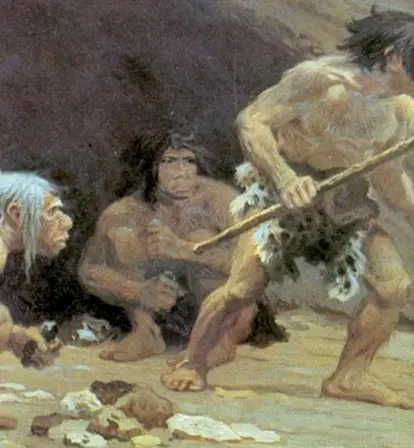Neanderthals are often characterized as primitive and unintelligent, but this extinct hominin species was made up of sophisticated hunters who preyed on megafauna.
Once upon a time, well, 400,000 to 40,000 years ago to be more exact, a superbly adapted cold weather human occupied all the land from Africa to Scandinavia called Neanderthal. The Neanderthal was not a direct ancestor of modern human, at one point, Neanderthals and modern humans even coexisted. They were tremendously diverse and existed far longer than modern humans have so far.
So how did modern humans seemingly come to replace these hardy, weather-worn people of the past?
Discovering The Neanderthal
In 1856, workers at a limestone quarry in the Neander valley near Dusseldorf, Germany found some scattered bones at their worksite.
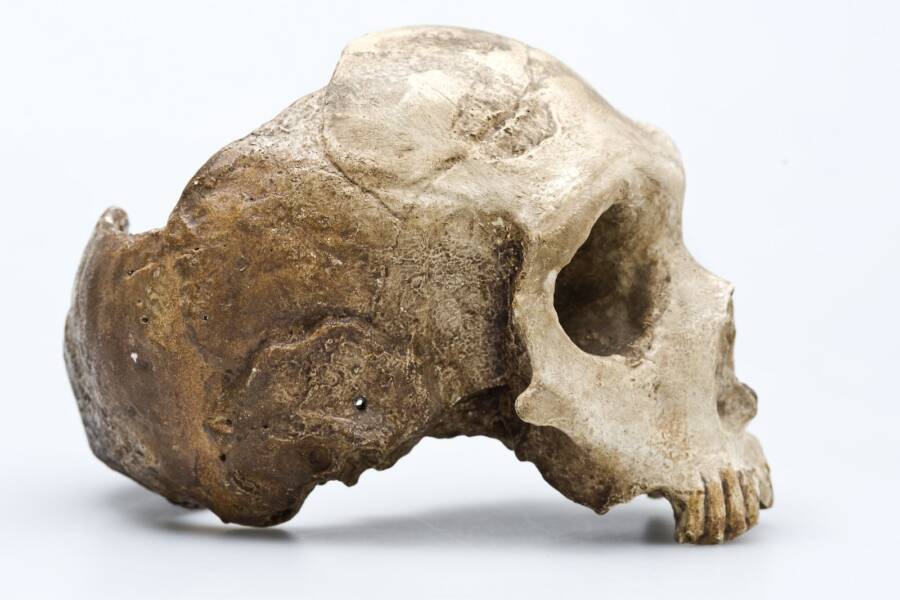
Carl Bento/Australian MuseumA cast of the Le Moustier skull, a 45,000-year-old skull belonging to a Neanderthal teen discovered in Le Moustier, France.
At first, they thought they were the remains belonged to a deformed human with thick bones and a tapered forehead. Modern dating methods hadn’t been developed yet, but the bones were clearly very old. After the reconstruction of the skull, it also became clear that the remains were actually from a very different kind of human that no one had ever seen before.
Except, they had, albeit unknowingly. In both 1829 and 1848, similar bones had been recovered, but until 1856, researchers weren’t able to connect them.
In 1868, the great naturalist Ernst Haeckel proposed the species name Homo stupidus for this primitive man, but his suggestion was too late to be given priority. In 1864, William King had already proposed Homo neanderthalensis, the Neanderthal.
Later, King changed his mind that Neanderthals were human at all, and urged that the species be given a separate genus classification on the grounds that these pre-humans would not have been capable of “moral and theistic conceptions,” but the name – and the classification of Neanderthal as an early man – stuck.
What those workers found in 1856 was only the beginning of a long investigation into ancient man’s origins. Today, over 400 individual Neanderthals have been found in sites as far apart as Portugal and Kazakhstan.
Placing The Neanderthal In Evolution

Carl Bento/Austrlaian MuseumNeanderthals had thicker bones, tapered foreheads, and more recessed chins than modern humans.
Nineteenth-century biologists tried to describe Neanderthals’ place in the human family. The theory of evolution was only just published in 1859, a few years after the first Neanderthal was discovered, and so the specimens were shoehorned into that framework by people who really hadn’t yet grasped what Darwin had theorized.
Understanding these ancient people was also hampered by the almost total lack of other ancient human remains with which to compare Neanderthals.
In this context, it’s not surprising that Neanderthals were put in an intermediate stage between apes and modern men. Illustrations were made in the literature of stooped, brutish cavemen who were no more intelligent than apes and sometimes lived in trees. It has taken generations to undo these early depictions and in some corners of the world this idea persists.
Creationist literature, for example, often portrays Neanderthals as fully modern humans and suggests that one of the first described specimens was just an old man with arthritis who was stooped over with age. No mention is made in these books of the 399 other Neanderthals that had since been discovered, nor is an opinion given as to whether they all had arthritis.
The Anatomy And Culture Of Neanderthals

Natural History MuseumA front and back view of a Neanderthal skeleton.
Taken together, these remains reveal an ancient human that was about a foot shorter than modern humans and much stockier. They had a more oval-shaped skull with a low forehead, heavy brows, and a bun on the back of their skull where powerful neck muscles attached. This trait is uncommon in modern humans.
Their short femurs and humerus bones made them physically resemble Barney Rubble. They had other subtle distinctions, such as a solid brow ridge, where modern people have a gap between brows. Their jaws were far larger and more solidly built, but with very weak-looking recessed chins. Their teeth were different shapes from ours, as were their large noses.
Neanderthals also had very thick bones and overgrown roughened areas where their muscles attached suggesting they had tremendously large, powerful, and overused muscles. Most Neanderthal remains reveal healed injuries that would have been life-altering emergencies for modern people – smashed skulls, multiple broken bones, bone spurs where old injuries had healed imperfectly, and so on.
When compared with similar injury patterns in modern humans, the closest match with Neanderthals is found among rodeo workers, suggesting frequent run-ins with angry wild animals which is consistent with the other things we know about these ancient humans. From animal bones found in their campsites, Neanderthals seemed to have been mainly big game hunters where our own immediate ancestors specialized in smaller things like rabbits and birds.
Neanderthals would have lived in a world full of mammoths and wooly rhinoceroses, cave bears, and giant predatory cats, such as the European lions and hyenas. These ancient humans would have competed with these gigantic predators for food.
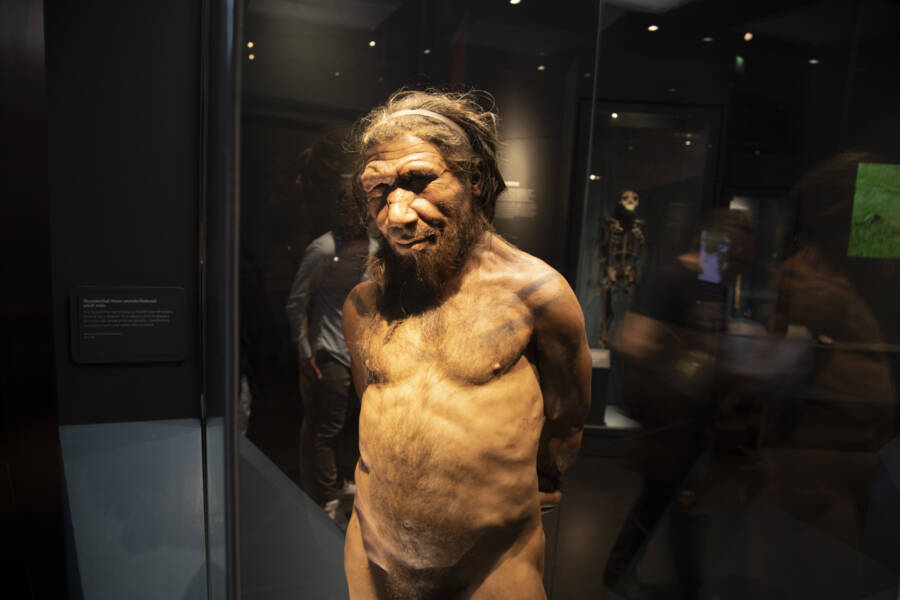
Mike Kemp/In Pictures via Getty Images ImagesNeanderthal man at the human evolution exhibit at the Natural History Museum in London, England.
The tools of Neanderthals are immediately discernible from those of early modern humans. Neanderthals preferred to wrap cord around necklace ornaments, rather than to pierce and string them with beads, for example. When they did drill holes, instead of spinning a sharp tool against the surface the way we do, Neanderthals cut little “X”‘s at different angles before scraping out a diamond shape and finally punching out through these cuts.
Their dead were buried with goods and sometimes revisited and dug up to have their bones decorated.
These are signs that the Neanderthals had some ideas about life after death. Far from having “no grasp of moral and theistic concepts,” the way Haeckel thought, Neanderthals seemed to have been the first humans to think about those concepts at all. These were not modern people, but clearly, they weren’t coarse brutes either.
Life And Diet In The Ice Age
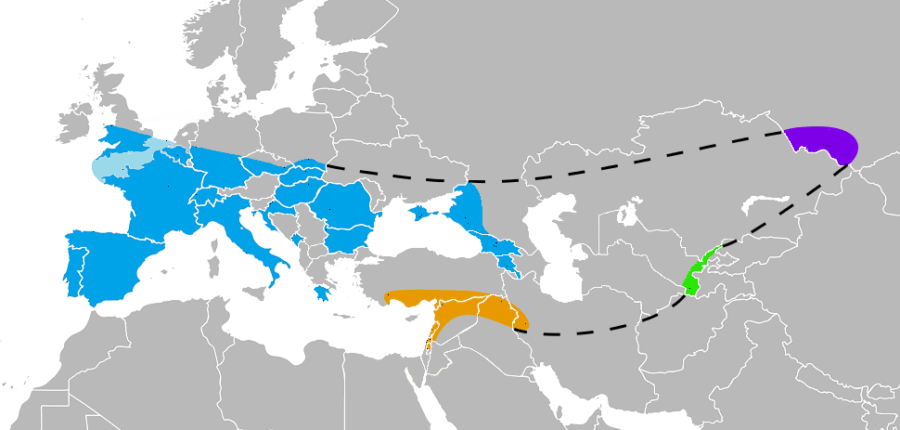
Wikimedia CommonsKnown Neanderthal range in Europe (blue), Southwest Asia (orange), Uzbekistan (green), and the Altai mountains (violet), as determined by where their remains were later found.
Everything about Neanderthal anatomy reveals the conditions of the world in which they lived. Short stature is typical of cold-climate species as are stocky limbs and a dense core. Warm-blooded animals have delicate bony structures in their noses called respiratory turbinates (RTs). RTs act like a natural heat exchanger, but Neanderthals had very large RTs compared with our own, which again suggests that these people lived in extremely cold climates.
None of this is surprising since we know that the world in which they lived was prone to massive ice ages. Ours is too, but the glaciers come and go on a roughly 26,000-year cycle.
For the last 12,000 years or so, we’ve been living in what’s called an interglacial period; the ice age is still on, but the glaciers have receded, allowing for the growth of deserts like the Sahara. In the Neanderthals’ world, however, North Africa and the Middle East were temperate grasslands while in Europe there was a solid ice sheet as much as a mile thick that reached as far south as where Munich, Germany is now.
The area around this ice resembled much of Alaska and arctic Siberia, with low lichen growth and very little life. Unsurprisingly, fossilized feces from this period reveals that the Neanderthals’ diet could contain as much as 90-percent meat, which could only have come from seasonal hunting, mostly of reindeer in the winter and red deer in the summer.
Modern people who’ve experimented with the Atkins Diet know that we can’t really thrive on an all-meat regimen, but Neanderthals lasted hundreds of thousands of years on exactly that. Studies of their remains suggest that Neanderthals may have consumed up to 50 percent more calories in a day than we do, which is consistent with the rodeo-rider lifestyle they seem to have lived.
The Human Family Tree And The Arrival Of Modern Man
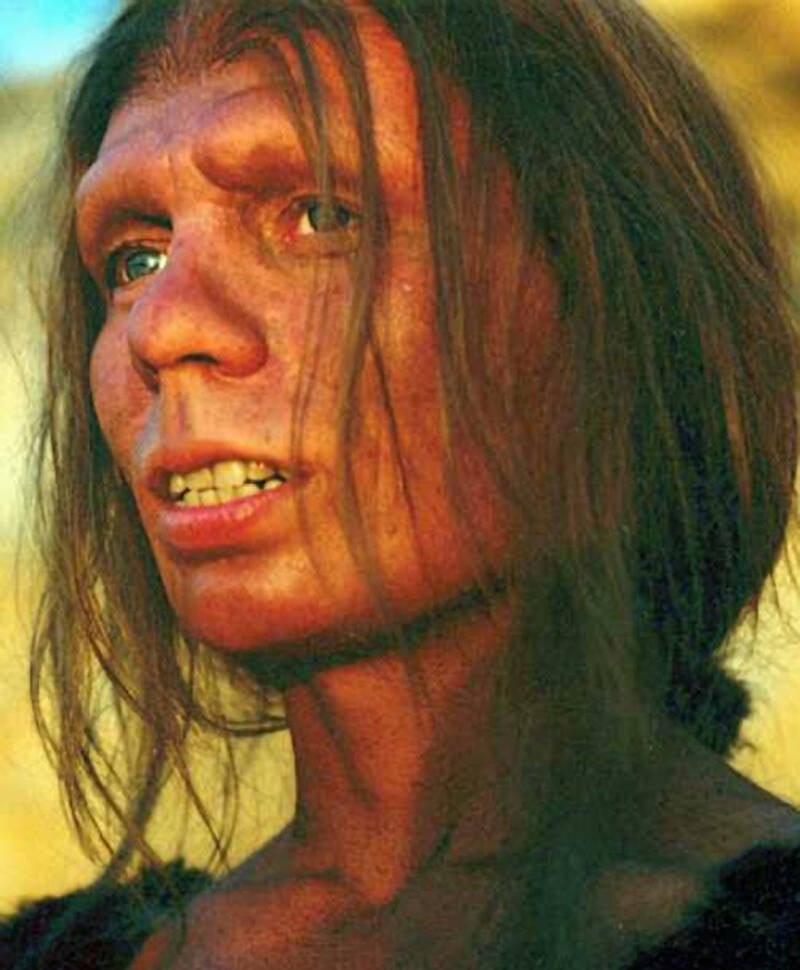
Wikimedia CommonsA reconstruction of a Neanderthal woman.
Though Neanderthals are not direct ancestors to modern humans both emerged from the same primordial population. Between 600,000 and 800,000 years ago, a group split off from H. antecessor – itself a variety of H. erectus – and began to populate Europe and the Near East.
There’s a fossil gap after that, but a 2016 paper published in Nature establishes a DNA link between a group called H. heidelbergensis and all the known groups of later Neanderthals. It seems that Neanderthals had Europe and Central Asia to themselves for around half a million years.
They weren’t idle, though. During that time, another group split off from them and headed east, where they developed into a group called the Denisovans, whose physical remains resemble Neanderthals’ and are known from a site on the Russian border with Mongolia. By 250,000 years ago, the world seems to have been split between the most direct ancestors of modern humans in Africa, an unknown human relative in West Africa, Denisovans in the Far East, a descendant of H. habilis in Indonesia we now call the Hobbits, and Neanderthals in Europe and Mesopotamia.
Other groups may have been scattered around the Old World, but the picture by now is so crowded that anthropologists are frankly having a hard time keeping all the different groups straight and establishing for sure who is directly related to who.
Around 70-50,000 years ago, they too made the trek into the Near East. There, they met Neanderthals and gradually replaced them. At each site, there is a clear progression: pure Neanderthal remains transition into a mix of Neanderthal and modern human artifacts and skeletons, followed a few thousand years later by modern human remains alone.
Whether the Neanderthals were replaced by violent conflict or otherwise is still debatable but, there is unambiguous evidence in the Levant by around 50,000 years ago, followed in sequence in Turkey, the Balkans, Central Europe, and – by 40,000 years ago – France where, between 30,000 and 28,000 years ago, a human child in what is now Le Rois was found buried wearing a necklace made from the jawbone and teeth of a Neanderthal.
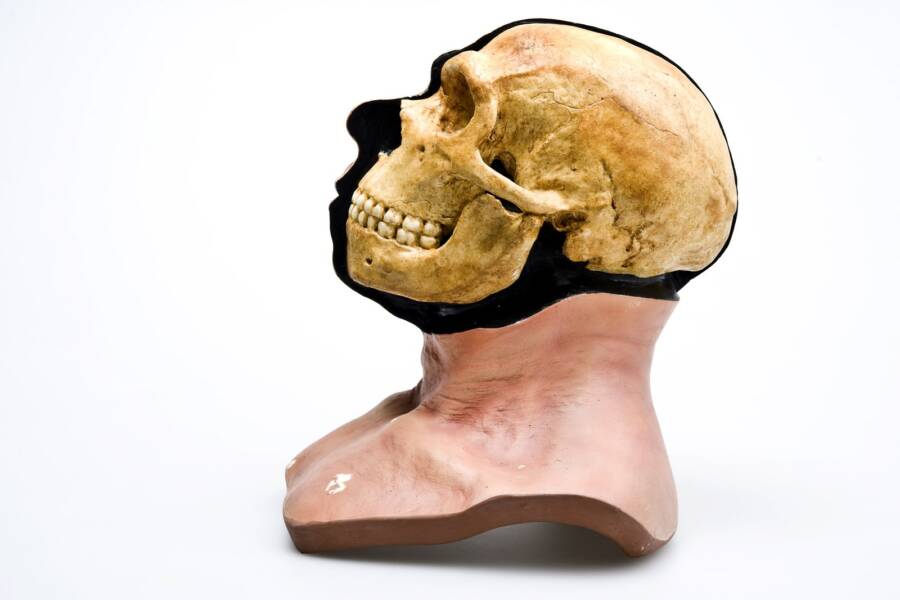
Carl Bento/Australian MuseumA reconstruction of a Neanderthal male’s head and skull.
The jawbone showed scrape marks consistent with a stone knife cutting out a tongue. To some, this was a clear example of how modern human ancestors butted heads violently with the Neanderthals and, perhaps, in some instances even ate them.
Overall, the entire picture of the extinction of the Neanderthal is one of smooth displacement across thousands of miles of terrain in a clean sweep that took no more than 20,000 years.
In the East, where Denisovan sites are scarce, the picture is less clear, but even on the island of Flores, where the Hobbits had lived for hundreds of thousands of years, the last of their kind seems to have gone out shortly after H. sapiens would have arrived.
By the year 10,000 B.C., our direct ancestors had the entire world to themselves.
The Extinction Of The Neanderthals
In 1998, in the central Portuguese town of Abrigo do Lagar Velho, the remains of a 4-year-old boy were recovered from their burial site in a cave. The child had been buried with grave goods, and his bones were dusted with red ochre, which suggests a return to the gravesite by the family to adorn the skeleton well after burial.
The child’s skeleton showed very humanlike proportions in the skull and teeth, but the rest of his body was a dead ringer for a Neanderthal child of the same age. The remains were dated to 24,000 years ago. The Neanderthal finding has, of course, been disputed, but if there’s anything to it, the Lagar Velho specimen represents the last known Neanderthal in the world.
Though, not exactly.
At the time of the Lagar Velho find, there was a raging controversy among scientists over whether Neanderthals had been driven entirely extinct or if there had been some interbreeding between them and early modern humans. Post-Human Genome Project work since 2010 in genetics has found several sections of Neanderthal DNA in modern humans that seemed to put that debate to rest.
It actually seems that there have been a couple of occasions when modern human ancestors and Neanderthals shared genes, but the most massive transfer took place as Neanderthals were being displaced in the great post-African migration. None of the known Neanderthal genes have made their way into African populations, which makes sense since modern Africans are the descendants of the people who stayed there while their cousins left, but everybody whose ancestry is from Europe and Asia has at least some admixture.
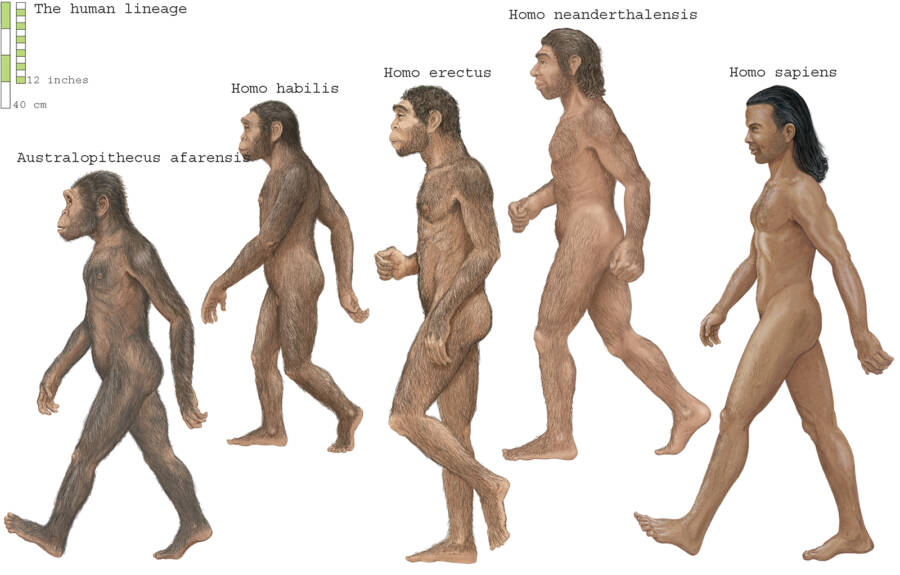
Encyclopaedia Britannica/Universal Images Group via Getty ImagesGroup of Homosapiens, Australopithecus afarensis, Homo erectus, Homo habilis, and Neanderthal.
How much Neanderthal you have depends on where you’re from. East Asians have very little, around one percent of their total genome. While they don’t have a lot of classic Neanderthal ancestry, East Asians do have quite a bit of Denisovan genes; around three to five percent.
Papuans and Australian Aborigines have up to 6 percent Denisovan DNA. Europeans have little to no Denisovan, which also makes sense since they were an Asian Neanderthal variety, but people from Europe do have three to five percent classic Neanderthal in them. That doesn’t sound like much, but five percent of your ancestry today is like having a great-great-great-grandparent who was pure Neanderthal alive at the same time as Ernst Haeckel.
In that sense, then, if your ancestors lived anywhere in the world but Africa, the last Neanderthal is in you.
After this looking at this answer to the question of what are Neanderthals, read about some modern West Africans have DNA that’s not linked to any known human ancestor. Then, check out how the modern human tongue can actually smell.
